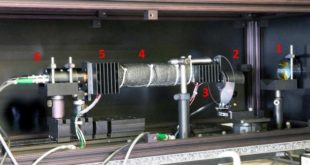Science stinks. So thought Megan Harries as she measured drops of putrescine and cadaverine — the chemicals that give decomposing corpses their distinctive, terrible odour — into glass vials. She then placed the vials on the floor of a shipping container, walked outside, and closed the door behind her. Harries, …
Read More »NIST presents first real-world test of new smokestack emissions sensor designs
In collaboration with industry, researchers at the National Institute of Standards and Technology (NIST) have completed the first real-world test of a potentially improved way to measure smokestack emissions in coal-fired power plants. The researchers are presenting their work this week at the 2019 International Flow Measurement Conference (FLOMEKO) in …
Read More »Precise temperature measurements with invisible light
Ordinarily, you won’t encounter a radiation thermometer until somebody puts one in your ear at the doctor’s office or you point one at your forehead when you’re feeling feverish. But more sophisticated and highly calibrated research-grade “non-contact” thermometers–which measure the infrared (heat) radiation given off by objects without touching them–are …
Read More »Photonic radiation sensors survive huge doses undamaged
Researchers at the National Institute of Standards and Technology (NIST) have published landmark test results that suggest a promising class of sensors can be used in high-radiation environments and to advance important medical, industrial and research applications. Photonic sensors convey information with light instead of electric currents in wires. They …
Read More »A new way to measure nearly nothing
Many semiconductor fabricators and research labs are under increasing pressure from, of all things, vacuum. These facilities need to remove greater amounts of gas molecules and particles from their setups as new technologies and processes demand lower and lower pressures. For example, the vacuum chambers in which microchip manufacturers lay …
Read More »NIST method measures 3D polymer processing precisely
Recipes for three-dimensional (3D) printing, or additive manufacturing, of parts have required as much guesswork as science. Until now. Resins and other materials that react under light to form polymers, or long chains of molecules, are attractive for 3D printing of parts ranging from architectural models to functioning human organs. …
Read More » Instrumentation Monthly Test | Measurement | Control
Instrumentation Monthly Test | Measurement | Control





